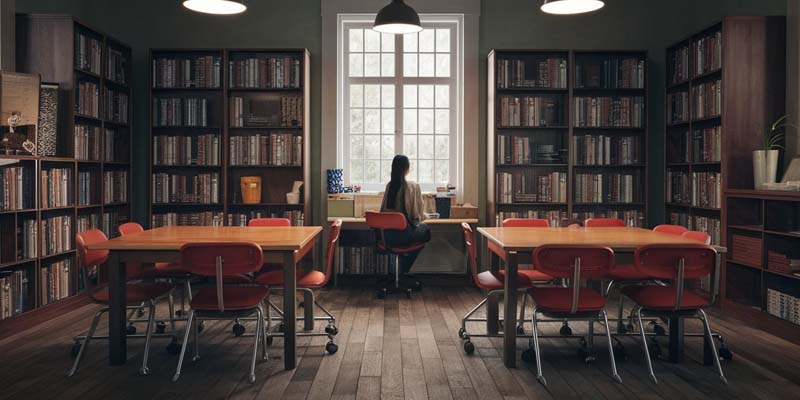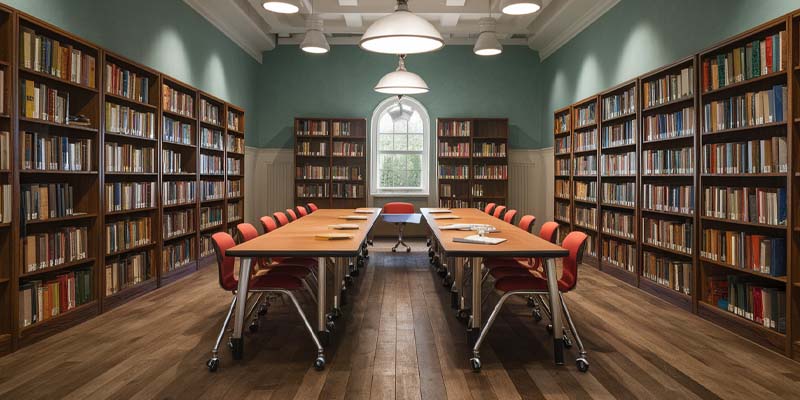The Importance of Mobility in Schools and Educational Facilities
Aug 26th 2024
Table of Contents
- 1.The Need for Mobility in Schools
- 2.Types of Casters for Educational Furniture
- 3.Chair Casters
- 4.Table Casters
- 5.Casters for School Library Furniture
- 6.Selecting the Right Casters for Different Furniture Types
- 7.Casters for Table Legs
- 8.Casters for a Workbench
- 9.Benefits of Mobile Furniture in Educational Facilities
- 10.Maintaining and Repairing Casters
- 11.Caster Maintenance
- 12.Wheel Maintenance
- 13.Caster Repair
- 14.Specialized Casters for Lab and Technical Furniture
- 15.Wrapping up
Walking through a modern classroom recently, I noticed a significant shift from the rigid rows of desks I remembered from my school days. Today’s educational spaces are designed for collaboration, adaptability, and student engagement. This transformation is driven by the need for flexible, mobile furniture that can easily adjust to various teaching styles and activities. Furniture casters, a seemingly small component, play a crucial role in this evolution. Casters for furniture enable the quick reconfiguration of classrooms, allowing educators to create a learning environments suitable for the diverse needs of students.
In this post, we’ll elaborate on the importance of mobility in schools and how investing in suitable casters can make all the difference.
The Need for Mobility in Schools
Modern classrooms are far more dynamic than the traditional, static environments of the past. Today’s educational spaces are designed to support a variety of teaching methods, from group collaboration to individual study and hands-on activities. This shift requires classrooms that can adapt quickly to different daily needs.
Mobile furniture plays a pivotal role in creating these adaptable learning environments. Desks, chairs, and storage units equipped with furniture casters allow educators to reconfigure spaces easily. Whether it’s rearranging desks for group work, clearing space for a project, or setting up a new activity, mobility is critical. The ability to quickly and efficiently alter the classroom layout helps maintain an engaging and flexible atmosphere that supports diverse learning styles.
School furniture designed for mobility not only improves the functionality of a classroom but also encourages creativity and collaboration among students. By incorporating casters for furniture, schools can optimize their spaces to be as versatile as the lessons taught within them. In a world where education is constantly evolving, the ability to move and adapt is not just a convenience—it's a necessity for fostering a thriving, modern learning environment.
Types of Casters for Educational Furniture

When selecting suitable casters for educational furniture, it's essential to consider each piece's specific needs. The suitable casters can significantly enhance the functionality and longevity of school furniture, contributing to a more efficient and adaptable learning environment. Below, we'll discuss the benefits and recommendations for chair casters, table casters, and casters for school library furniture.
Chair Casters
Chair casters are essential for improving classroom mobility, allowing students and teachers to move freely without disrupting the learning process. They come in various types, including hard plastic for carpeted areas and heavy-duty rubber casters for classroom chairs. Heavy-duty rubber casters are recommended to provide a smooth glide on hard floors and carpets while minimizing noise and preventing floor damage. These chair casters improve mobility and contribute to a more flexible and adaptable classroom environment, enabling quick transitions between different seating arrangements.
Table Casters
Table casters are crucial for workbenches and tables that must be frequently moved or reconfigured. Swivel casters with locks are particularly advantageous for tables, offering mobility and stability. These table leg casters allow easy movement when needed, and the locking mechanism ensures that tables remain securely in place during use. This combination is ideal for classrooms where tables are often rearranged to suit different activities or teaching styles. By using table casters, schools can create versatile spaces that can be quickly adapted to meet the evolving needs of students and educators.
Casters for School Library Furniture

Mobility and quiet operation are critical factors in maintaining a conducive environment for learning in school libraries. Nylon casters are an excellent choice for school library furniture, offering a peaceful and smooth roll that minimizes disruptions. These casters are ideal for bookshelves, carts, and other library furniture that must be repositioned frequently. Using nylon casters, schools can maximize the flexibility of their library spaces, allowing for easy reconfiguration to accommodate different activities, such as group study sessions or presentations, while maintaining a quiet atmosphere.
Selecting the Right Casters for Different Furniture Types

Choosing the right caster wheels is crucial for ensuring the safety, durability, and functionality of educational furniture. Different types of furniture require specific casters that can handle their unique demands. Selecting the appropriate casters improves mobility and ensures the furniture can withstand daily use in a school environment. Below, we’ll discuss choosing the best casters for table legs and workbenches, focusing on stability, safety, and durability.
Casters for Table Legs
Stability and ease of movement are vital considerations when selecting casters for table legs. Tables in educational settings are often moved to accommodate various activities, so choosing casters that provide smooth mobility and robust support is essential. Steel casters are highly recommended for their durability and strength, making them ideal for tables requiring frequent movement and heavy use. Steel casters can support significant weight and resist wear, ensuring that tables remain stable and secure even when fully loaded. Schools can ensure that their tables are easy to move and built to last by opting for steel casters.
Casters for a Workbench
School workbenches, especially in workshops or science labs, require casters to handle heavy loads while ensuring safety and functionality. Dual-wheel casters are an excellent choice, as they offer better weight distribution and stability. These casters are designed to support the significant weight of tools, equipment, or projects on a workbench, preventing tipping or uneven movement. Additionally, dual-wheel casters provide better traction and control, which are essential in environments where safety is a priority. By selecting dual-wheel casters, schools can ensure that their workbenches remain secure, functional, and easy to reposition.
Benefits of Mobile Furniture in Educational Facilities
Mobile furniture in educational facilities offers unparalleled flexibility, transforming how classrooms and other learning spaces are used. This adaptability is crucial in modern education, where teaching methods are increasingly diverse and dynamic. With mobility solutions, educators can quickly and easily reconfigure spaces to suit various activities, from group projects to individual study sessions.
One of the key benefits of mobile furniture is its ability to improve collaborative learning experiences. In traditional, static classrooms, arranging students into groups or creating an interactive setup can take time and effort. However, mobile furniture with quality casters, tables, chairs, and even whiteboards can be effortlessly moved and adjusted. This encourages a more fluid and interactive learning environment where students can easily collaborate, share ideas, and collaborate on projects. The ease of movement and reconfiguration supports a more engaging and inclusive atmosphere, catering to different learning styles and needs.
Another significant advantage of mobile furniture is the ease with which spaces can be reconfigured. Whether transforming a classroom from a lecture setup to a collaborative workspace or turning a library corner into a group study area, mobility solutions allow for quick changes without disrupting the flow of the day. This flexibility is essential in schools with limited space, where multi-purpose rooms must serve different daily functions. Mobile furniture ensures that each space can be optimized for its current use, thus adding to the efficiency of the facility.
In conclusion, incorporating mobile furniture into educational facilities provides critical flexibility, fosters collaborative learning, and allows for the seamless reconfiguration of spaces. By investing in the proper mobility solutions, schools can create adaptable environments that meet the evolving needs of students and educators, ultimately leading to more effective and engaging learning experiences.
Maintaining and Repairing Casters
Proper maintenance and timely repairs of casters ensure the longevity and functionality of mobile furniture in educational settings. Regular upkeep keeps away minor issues from becoming major problems, saving time and money in the long run. Below, we’ll cover essential tips for caster maintenance, wheel maintenance, and basic caster repair.
Caster Maintenance
Caster maintenance should be a routine part of keeping school furniture in optimal condition. Regular checks and cleaning are vital to prolonging the life of furniture wheels and caster chairs. Start by inspecting casters for signs of wear, such as flat spots, cracks, or loose components. Dirt may accumulate in the wheels, leading to poor performance and potential damage. It’s essential to clean casters regularly, using a soft brush or compressed air to remove buildup. Lubricating the wheel bearings with a light oil can also help maintain smooth operation. Schools can prioritize caster maintenance to ensure their mobile furniture remains safe, functional, and easy to move.
Wheel Maintenance
Maintaining the wheels of casters is crucial for ensuring smooth operation and handling the wear and tear that comes with daily use. Wheel maintenance involves checking for uneven wear, leading to instability or difficulty moving furniture. If wheels show excessive wear or damage, replace them promptly to avoid further issues. Additionally, ensuring the wheels are correctly aligned and free from obstructions will help maintain their performance. Regular wheel maintenance adds to the longevity of the furniture and also improves the safety and ease of use in busy educational environments.
Caster Repair
Despite regular maintenance, casters may still encounter issues that require repair. Common problems include broken wheels, stuck swivels, or loose mounting plates. Simple DIY fixes, such as tightening screws or replacing worn wheels, can often resolve these issues. However, if the damage is extensive or affects the caster’s structural integrity, it’s advisable to seek professional help. Professional caster repair ensures that the furniture remains safe and functional, avoiding the potential hazards of poorly repaired casters.
Specialized Casters for Lab and Technical Furniture
Mobility is crucial for maintaining a flexible and efficient workspace in lab environments. School furniture, such as lab tables and workstations, must often be moved or reconfigured to accommodate different experiments and activities. Using specialized casters, like chemical-resistant casters, ensures that lab tables can be safely and efficiently relocated without compromising the equipment's integrity or the space's safety. These casters can withstand exposure to harsh chemicals, adding to safety and durability. By incorporating suitable casters, schools can create technical rooms that are not only adaptable but also safer and more efficient.
Wrapping up
Incorporating mobility into educational facilities is not just a matter of convenience; it's a strategic approach to fostering dynamic and adaptable learning environments. Suitable casters are pivotal in improving flexibility, safety, and efficiency from classrooms to labs. Investing in quality casters ensures that furniture can meet the evolving demands of modern education. Atlanta Caster offers various premium casters to suit multiple educational needs. To find out how our casters can transform your learning spaces, contact Atlanta Caster today and take the first step towards a more versatile educational environment.




 Email US
Email US
 Hours
Hours
 Visit Our Showroom
Visit Our Showroom




